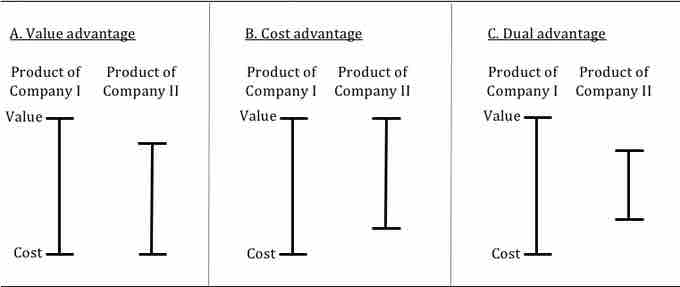Competitive Strategies
From a managerial perspective, competition generally falls into the external environment, though it can also take shape in the internal environment through rivalry between strategic business units (SBUs). For managers, understanding the external competitive landscape is a critical factor in assessing company strategies and benchmarking appropriately to ensure the competitiveness of the firm. Businesses that fail to keep pace with their rivals will eventually be overpowered and often forced to develop an exit strategy.
Avoiding the risks of competitive factors demands a strong understanding of operational efficiency (low cost), quality production, differentiation, and competitive advantage—or who you target and whether or not you have a cost or quality advantage (see figure below).

Cost vs. quality
Companies generally achieve either a cost or a quality advantage (very rarely, both). In panel A, both companies' products have the same cost, but Company I's product has higher value. In panel B, both companies' products have the same value, but Company I's product has lower cost. In panel C, Company I's product has both higher value and lower cost (this is the rarest situation).
Low-Cost and Branding
The simplest perspective on competition is in industries where products are homogeneous (or very alike). In such a situation, companies compete directly. For example, bottled-water producers are directly involved in such a framework and thus adopt two basic competitive strategies: low-cost and branding.
Low-cost suppliers find ways to optimize their production and distribution to offer consumers the lowest possible price on one bottle of water. Low-cost suppliers often benefit largely from economies of scale. Branding, on the other hand, aims to convince the consumer that a higher price point is worth paying based upon the company's name, reputation, or other distinguishing characteristic. For example, Dasani brand water costs more than generic store brand water, despite being essentially the same product. Commercials, aesthetic presentation, goodwill, and factors other than price may then influence a consumer's purchasing decision.
Differentiation
Most products and services are not homogeneous, however, allowing incumbents in an industry to compete with one another by means of various competitive strategies. Differentiation is a competitive tactic wherein companies approach certain niche needs within an industry to capture a segment of the market share.
An example of differentiation might be cereal. There are hundreds of different kinds of cereals. The need being filled is sustenance: people need to eat. The producers of these cereals use differentiation to capture a share of the cereal market: some brands focus on their organic nature, others their sugary appeal, and still others on being "cool." Branding plays an important role here as well, though assessing niche consumer needs and filling them is the principal focus.
Quality
Finally, there is the potential to compete externally based upon quality. Toyota makes both the Corolla and the Lexus, thereby targeting both ordinary automobile drivers and those in the luxury-car consumer bracket. Quality competitive strategies, while related to branding, provide a particular level of quality to capture a specific income or interest demographic. The opportunity cost of efficiency is associated with quality, which generally sees higher price points. Quality is therefore a strong antithesis to the low-cost strategy.
Internal Competition
Businesses also compete internally, an intrinsically complex issue. On the surface, internal competition involves either direct product substitutes or funding competition (among different business units). An example of internal competition is PepsiCo. Pepsi makes both colas and sports drinks, all of which sit on the shelf next to one another. When a customer sees the sports drink and chooses it over the cola, the cola has lost a sale to an internal competitor. Pepsi, however, did not lose a sale; it merely lost one segment of the business while gaining another.
With these points in mind, managers must thoroughly understand the products they are pitching and which strategy will help them avoid going toe-to-toe with other businesses with whom they cannot compete. Starting up a car manufacturing business to compete with Hyundai in the low-cost market is extremely difficult, as Hyundai has economies of scale in place that will almost always beat smaller competition on a low-cost strategy. This example illustrates an extremely important point in business: rely on strengths. Managers must understand their own competitive advantage (what they do better than the competition) to adopt the appropriate competitive strategy to gain market share and remain profitable.